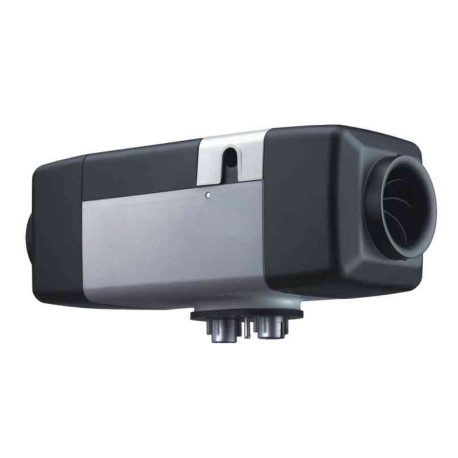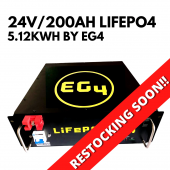FALL UPDATE:
Yes, it's fall time up here in the north. And with that comes the switch from cooling to heating. I'm learning alot as we go with this thing.
As you know from the original post, I'm using 4x Valence 27 series batteries, which total 7064wh if new condition... and I'm running used batteries. But before we do the heat cycle test, lets get the battery cycle test done first so we have a solid baseline to read from:
Every season ending I run the battery bank down to the inverter voltage cut off... This is achieved by leaving the ac loads ON (this time the heat pump in heat mode) until the low voltage is achieved, at 11.4v. The invertor cuts off, and the system just sits and waits for me to do something. I do this test with all charge modes switched OFF so I can have a controlled study of the re-charge cycle.
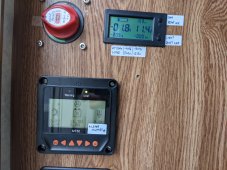
Next task was to plug in the laptop to the battery bank and check out what's going on there. Nice that the Valence software will continuously record a CSV file of the data every minute, and therefore I can actually check everything AFTER the charge.. which is really handy.
Here's a shot of the software with the menus for logging at the bottom right, and the current state of low charge:
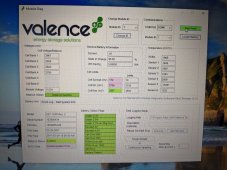
Next up is to plug in my AC wall charger.. which I made up from a 40v power supply. It's shown below.
This little thing is AMAZING. It's supposed to be 400 watts output at 40v DC.. which is more like 500+ watts output at 40vdc! Love this thing. Cheap, and it just plain works great.
NEWS: do NOT ever plug this into your battery. I use this as a SOLAR PANEL REPLACEMENT device... it is plugged into the back of my red selector switch and therefore it will be powering the INPUT on my solar charge controller. This method is completely SAFE as a charger because the same exact charge settings are being used, as if we were just powered by the sun. NO change in settings.
So then, with the 110v to 40vdc power supply plugged in and the power flowing, we're doing a constant fed, linear input, invariable supply 'solar' charge with measureable inputs. Perfect.
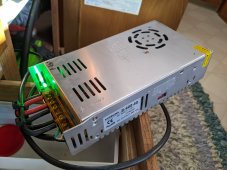
It's time to charge! Yay! And log everything. I've turned on the 'continuous sampling' button on the bottom right of the Valence software to begin the storage of data, and then reset my consumption meter to ZERO watthour reading so I can track that input exactly. ALL of the loads in the RV are turned off. Everything. And here we charge!
Fast forward 8 hours, and there's a BUNCH of charging coming up as shown by the pic below. We're up to 3.35 volts per cell on the software, and there's BALANCING!!
I've known about this for a while, but there's a LOAD of internet warriors who swear that Valence batteries do not operate at all internally without the proper external BMS attached, and this is false information. There's a balance and monitoring system inside these, and they ALL talk to eachother when plugged in battery to battery. You DO NOT need any external items to make this work.
You'll notice on the middle left side of this picture that the yellow BALANCE ACTIVE tab is now lit, and before it was NOT, (other pics) showing there's a change of state. It's also recorded on the CSV file in the data logging.

Anyway, I'm loving all this data.
So, at the end of 13 hours of charging here's my results:
Charge parameters always set to full stop at 14.00 volts total pack, after all top balancing at 14.00 volts. This is my personal preference, as the new battery recommendation is 14.6v top charge, and I'm dealing with ~240 ish cycles on the batteries, and they are 10 years old already.
So we stopped at 14.0v and that yielded me a total battery input of 5920wh input.
INFO: New batteries are rated at 7066wh for my pack new.. and I put in 5920, which is 83% of new capacity... reminder.. I did not drain all the way or charge to the full cap top of 14.6, so I'm VERY HAPPY with this result.
Using the nominal voltage of my batteries (12.8v) that's a amp hour input of 462ah. Considering the new rating of my pack (138x4) is 552ah new, I'm very happy with that input, which also maths out to 83% of new capacity.
VERY HAPPY. And I can accurately reset my consumption meter total to the charged AH rating I received on charge, and therefore better monitor my usage and remaining power. Awesome. This activity every fall season allows me to track the health of my battery pack. It's easy, and effective, and the numbers don't lie to you. Next season, I can repeat the test shown above, and see how my battery health is doing, or decaying, over time and cycle count increases.
Moving on to the next test, which is the point of this thread (haha, sorry for the back story on the charging).
I'm going to put the heat on. And I'm going to disable all other loads. And I'm going to disable all charging.
Test parameters: Raise the inside RV temperature from 52f to 70f for a total time of 12 hours.
Fresh battery top balance, controlled charge finished, then ZERO out the consumption meter watt hours.
Turn on inverter, turn on mini-split to heat cycle, auto fan, and set temperature. 8pm.
In the morning, 8am return to find out the total usage. Turns out that heat cycle overnight consumed almost exactly 3000wh to do it's job. (there was no body heat helping out during the night, the RV was empty).
And this is what I wanted to know. And this is why it's unlikely people will ever use these for fall or winter heat sources in RV setups. Reasons:
First off, when we do AC, we do it because it's hot and sunny. If it's sunny we get solar input. This can offset the consumption of the AC load, and in my case it's basically neutral losses. (so awesome).
But heating is a TOTALLY different thing. The style and softness and quiet heat of the mini split is very desirable. So nice. But it's doing most of it's work during times when it's got NO input offset. ALL heat energy is done during low or no solar input (night, evenings, etc) and therefore it's totally operating on battery.. again NO offsets for the power load.
This becomes a problem in RV solar setups like mine, because even though I can offset the AC in the sunshine, I heat only during the WORST sun conditions... low angle, and low time... which is fall and winter. And because the heat cycle almost always uses battery alone, and I have less charging from the sun angle etc, the system has to struggle to recover that lost energy from overnight.
I used 3000wh on my test overnight.
This means I have to recharge from solar at least this much again next day. That's 600w incoming for 5 hours straight just to recover the heating last night. But it's cloudy and raining. So that's basically NOTHING coming in. And I'm not going to be able to heat another night with my battery alone.
And that rests my case... and the test. As I know already, I can keep up with the AC loads, thanks to the high sun angle, heavy charging, long days, and need of use during solar production hours. The heat cycle is all that in opposite.. worst sun angle, low charge times, heavy battery loads, and opposite use-to-production time of day.
Of course, the answer is add more solar! Yes, that's the plan.







